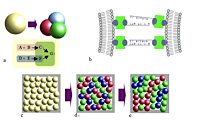Vesicle-based reactors, which, as a function of the employed modules and spatial structuring, show specific behavior, are scientifically interesting. But they are only suitable as a base for a novel production- and process-technology if their behaviors are not found just by accident and depend in an erratic manner on the choice of the used components and their coupling. Therefore, in future projects, it will be our aim to create "programmable matter". This means: We identify a number of chemical modules and depending on the way these components are arranged in assemblies, different emergent functionalities will result, as sketched in an example above. The structure of these assemblies is given by the choice of the adhesion elements used for the decoration of the vesicles. A main task in the realization of applications consists in the development of a scheme that at least stochastically predicts the functionality that emerges from a given set of linkers and vesicle contents and thereby forms the basis for establishing "programmable" reactors. We thereby envisage employing a methodology which is a mix of bottom-up simulation and top-down statistical means, which have been specifically developed by Irene Poli and co-workers at the University Venice.



